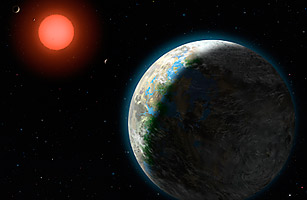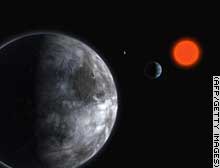
“‘We’re pretty excited about it,’ admits Steve Vogt, of the University of California, Santa Cruz, a member of the team, in a masterpiece of understatement. ‘I think this is what everyone’s been after for the past 15 years.’” And then some! Apparently, astronomers have discovered the most Earth-like planet yet in Gliese 581g, a relatively short 20 light years away.
“[I]t probably has a solid surface just like Earth. Much more important, it sits smack in the middle of the so-called habitable zone, orbiting at just the right distance from the star to let water remain liquid rather than freezing solid or boiling away. As far as we know, that’s a minimum requirement for the presence of life.“
Some might remember that Gliese 581c was all the rage two years ago. Apparently, this one — in the same solar system but only just discovered — is even closer to the real deal. (Good thing the NASA authorization just passed…)

